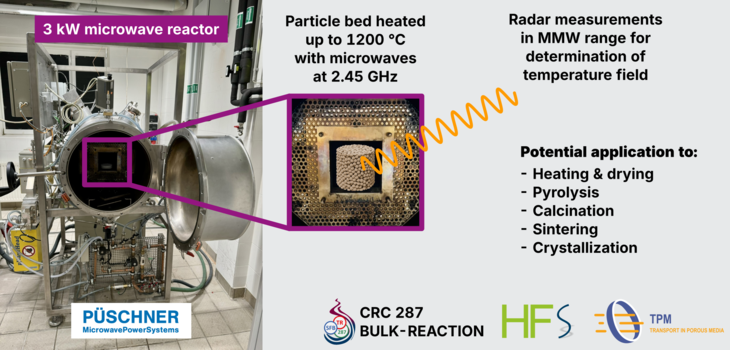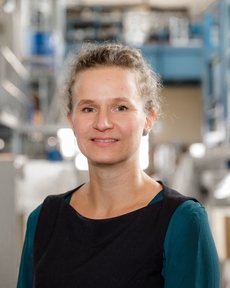Microwave Pyrolysis

Information
Electrification of thermal processes is key for the transformation of the industry towards carbon-neutral production. Depending on the technology, process intensification can be advanced in parallel to the defossilization. Microwave heating is very well known for its theoretically high energy efficiency. The fast internal heating additionally improves product yield and quality.
Pyrolysis of biomass, e.g. wood, is a promising conversion technology that enables production of feedstock chemicals from renewable resources, thus beeing an option for replacement of fossil resources like crude oil and gas. Microwave heating is knwon to affect the product quality and outcome composition during pyrolysis benefitially, while providing electrification of the process, therefore defossilization, as well.
But until now, an experimental gap hinders the advancement of microwave heating in high-temperature processes with phase change. So far, accurate models for high temperature microwave processes are not available. Operation of such processes is therefore hardly controllable. The overall conversion degree or inner material temperatures are not accessible inside of high-power electromagnetic fields.
In project B6 within the CRC/TRR 287 BULK-REACTION, we have the goal to develop a new measurement method that allows for the first time to monitor, both, material conversion due to phase changes and temperature inside of the products. This will be enabled by utilizing electromagnetic waves themselves for measurements, because their transmission, absorption and reflection is material composition and temperature dependent. Correlations of detected signals with material composition and temperature will be based on characteristic dielectric changes. 3D spatial resolution will be achieved by rotation of the sample during measurement. The experimental data sets will be combined with heat and mass transfer simulations, coupled with simulation of electromagnetic wave propagation, in order to gain a detailed insight into the thermal conversion processes.
Partners
-
Prof. Dr.-Ing. Alba Diéguez-Alonso
Technical University Dortmund
Transport Processes
Emil-Figge-Str. 68
44227 Dortmund
Germany
Homepage -
Dr.-Ing. Jan Barowski
Ruhr-University Bochum
Microwave Systems
Universitätsstraße 150
44801 Bochum
Germany
Homepage
Publications
-
Dernbecher, A., Bhaskaran, S., Vorhauer-Huget, N., Seidenbecher, J., Gopalkrishna, S., Briest, L., & Dieguez-Alonso, A. (2025). Investigation on the intra-particle anisotropic transport properties of a beech wood particle during pyrolysis. Particuology, 98, 172–190. https://doi.org/10.1016/j.partic.2025.01.006
-
Dernbecher, A., Bhaskaran, S., Vorhauer-Huget, N., Seidenbecher, J., Gopalkrishna, S., Briest, L., & Dieguez-Alonso, A. (2024). Evaluation of Convective Heat Transfer Inside the Pores of Pyrolyzed Wood using a µ-CT Based Realistic Geometry. In A. C. Benim, R. Bennacer, A. A. Mohamad, P. Ocłoń, S.-H. Suh, & J. Taler (Eds.), Advances in Computational Heat and Mass Transfer (pp. 386–395). Springer Nature Switzerland. https://doi.org/10.1007/978-3-031-66609-4_36
-
Vorhauer-Huget, N., Seidenbecher, J., Bhaskaran, S., Schenkel, F., Briest, L., Gopalkrishna, S., Barowski, J., Dernbecher, A., Hilfert, L., Rolfes, I., & Dieguez-Alonso, A. (2024). Dielectric and physico-chemical behavior of single thermally thick wood blocks under microwave assisted pyrolysis. Particuology, 86, 291–303. https://doi.org/10.1016/j.partic.2023.07.004
Projects
-
In-situ determination of heating and phase changes in a microwave heated packed bed reactor.
2024 – 2028
This project is part of the CRC/TRR 287 BULK-REACTION.
Funded by the Deutsche Forschungsgemeinschaft (DFG, German Research Foundation) – TRR 287 – 422037413.






